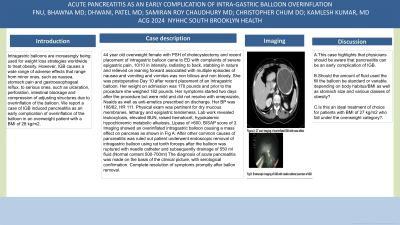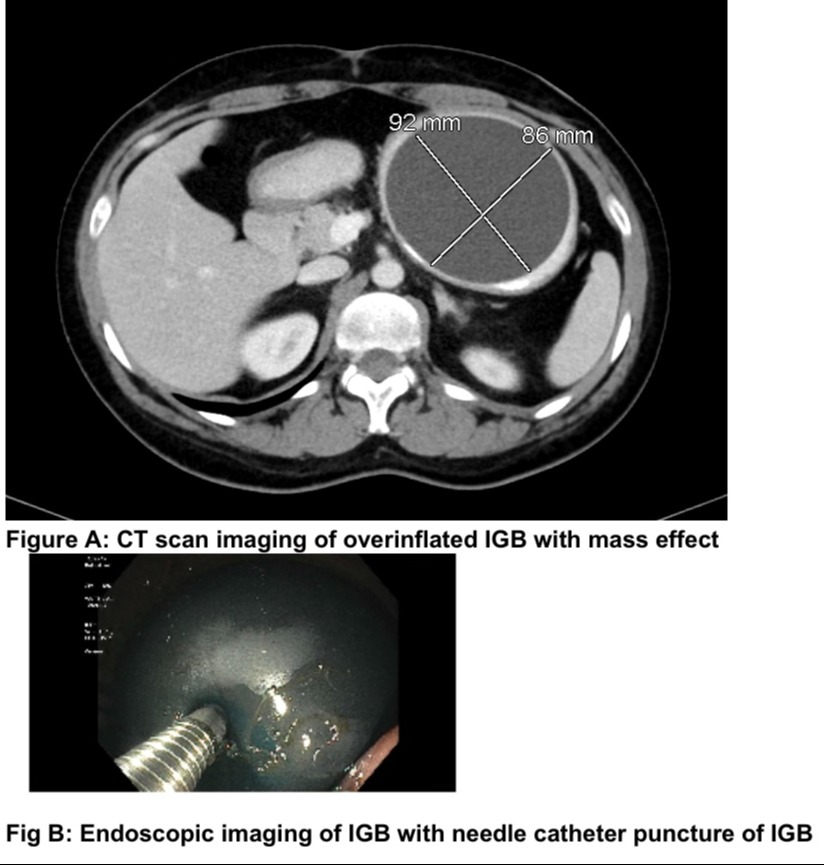Monday Poster Session
Category: Biliary/Pancreas
P1876 - Acute Pancreatitis as an Early Complication of Intra-Gastric Balloon Overinflation
Monday, October 28, 2024
10:30 AM - 4:00 PM ET
Location: Exhibit Hall E

Has Audio
- FB
Fnu Bhawna, MD
NYC Health + Hospitals/South Brooklyn Health
Brooklyn, NY
Presenting Author(s)
Fnu Bhawna, MD1, Dhwani Patel, MD2, Samiran Roy Chaudhury, MD3, Christopher Chum, DO2, Kamlesh Kumar, MD4
1NYC Health + Hospitals/South Brooklyn Health, Brooklyn, NY; 2South Brooklyn Health, Brooklyn, NY; 3NYC Health + Hospitals/South Brooklyn Health, New York, TX; 4Maimonides Medical Center, Brooklyn, NY
Introduction: Intragastric balloons are increasingly being used for weight loss strategies worldwide to treat obesity. However, IGB causes a wide range of adverse effects that range from minor ones, such as nausea, stomach pain and gastroesophageal reflux, to serious ones, such as ulceration, perforation, intestinal blockage and compression of adjusting structures due to overinflation of the balloon. We report a case of IGB induced pancreatitis as an early complication of overinflation of the balloon in an overweight patient with a BMI of 28 kg/m2.
Case Description/Methods: 44 year old overweight female with PSH of cholecystectomy and recent placement of intragastric balloon came to ED with complaints of severe epigastric pain, 10/10 in intensity, radiating to back, stabbing in nature and relieved on leaning forward associated with multiple episodes of nausea and vomiting and vomitus was non bilious and non bloody. She was postoperative Day 10 after recent placement of an Intragastric balloon. Her weight on admission was 170 pounds and prior to the procedure she weighed 182 pounds. Her symptoms started two days after the procedure but were mild and did not resolve with omeprazole, Nsaids as well as anti-emetics prescribed on discharge. Her BP was 106/82, HR 111. Physical exam was pertinent for dry mucous membranes, lethargy and epigastric tenderness. Lab work revealed leukocytosis, elevated BUN, raised hematocrit, hypokalemic hypochloremic metabolic alkalosis, Lipase of >600. BISAP score of 3. Imaging showed an overinflated intragastric balloon causing a mass effect on pancreas as shown in Fig A: After other common causes of pancreatitis was ruled out patient underwent endoscopic removal of intragastric balloon using rat tooth forceps after the balloon was ruptured with needle catheter and subsequently drainage of 550 ml fluid.(Normal content 500-700ml) The diagnosis of acute pancreatitis was made on the basis of the clinical picture, with serological confirmation. Complete resolution of symptoms promptly after ballon removal.
Discussion: A.This case highlights that physicians should be aware that pancreatitis can be an early complication of IGB.
B.Should the amount of fluid used the fill the balloon be standard or variable depending on body habitus/BMI as well as stomach size and various classes of obesity?
C.Is this an ideal treatment of choice for patients with BMI of 27 kg/m2 who fall under the overweight category?.

Disclosures:
Fnu Bhawna, MD1, Dhwani Patel, MD2, Samiran Roy Chaudhury, MD3, Christopher Chum, DO2, Kamlesh Kumar, MD4. P1876 - Acute Pancreatitis as an Early Complication of Intra-Gastric Balloon Overinflation, ACG 2024 Annual Scientific Meeting Abstracts. Philadelphia, PA: American College of Gastroenterology.
1NYC Health + Hospitals/South Brooklyn Health, Brooklyn, NY; 2South Brooklyn Health, Brooklyn, NY; 3NYC Health + Hospitals/South Brooklyn Health, New York, TX; 4Maimonides Medical Center, Brooklyn, NY
Introduction: Intragastric balloons are increasingly being used for weight loss strategies worldwide to treat obesity. However, IGB causes a wide range of adverse effects that range from minor ones, such as nausea, stomach pain and gastroesophageal reflux, to serious ones, such as ulceration, perforation, intestinal blockage and compression of adjusting structures due to overinflation of the balloon. We report a case of IGB induced pancreatitis as an early complication of overinflation of the balloon in an overweight patient with a BMI of 28 kg/m2.
Case Description/Methods: 44 year old overweight female with PSH of cholecystectomy and recent placement of intragastric balloon came to ED with complaints of severe epigastric pain, 10/10 in intensity, radiating to back, stabbing in nature and relieved on leaning forward associated with multiple episodes of nausea and vomiting and vomitus was non bilious and non bloody. She was postoperative Day 10 after recent placement of an Intragastric balloon. Her weight on admission was 170 pounds and prior to the procedure she weighed 182 pounds. Her symptoms started two days after the procedure but were mild and did not resolve with omeprazole, Nsaids as well as anti-emetics prescribed on discharge. Her BP was 106/82, HR 111. Physical exam was pertinent for dry mucous membranes, lethargy and epigastric tenderness. Lab work revealed leukocytosis, elevated BUN, raised hematocrit, hypokalemic hypochloremic metabolic alkalosis, Lipase of >600. BISAP score of 3. Imaging showed an overinflated intragastric balloon causing a mass effect on pancreas as shown in Fig A: After other common causes of pancreatitis was ruled out patient underwent endoscopic removal of intragastric balloon using rat tooth forceps after the balloon was ruptured with needle catheter and subsequently drainage of 550 ml fluid.(Normal content 500-700ml) The diagnosis of acute pancreatitis was made on the basis of the clinical picture, with serological confirmation. Complete resolution of symptoms promptly after ballon removal.
Discussion: A.This case highlights that physicians should be aware that pancreatitis can be an early complication of IGB.
B.Should the amount of fluid used the fill the balloon be standard or variable depending on body habitus/BMI as well as stomach size and various classes of obesity?
C.Is this an ideal treatment of choice for patients with BMI of 27 kg/m2 who fall under the overweight category?.

Figure: CT Abdomen and Endoscopic image highlighting Intragastric balloon
Disclosures:
Fnu Bhawna indicated no relevant financial relationships.
Dhwani Patel indicated no relevant financial relationships.
Samiran Roy Chaudhury indicated no relevant financial relationships.
Christopher Chum indicated no relevant financial relationships.
Kamlesh Kumar indicated no relevant financial relationships.
Fnu Bhawna, MD1, Dhwani Patel, MD2, Samiran Roy Chaudhury, MD3, Christopher Chum, DO2, Kamlesh Kumar, MD4. P1876 - Acute Pancreatitis as an Early Complication of Intra-Gastric Balloon Overinflation, ACG 2024 Annual Scientific Meeting Abstracts. Philadelphia, PA: American College of Gastroenterology.
